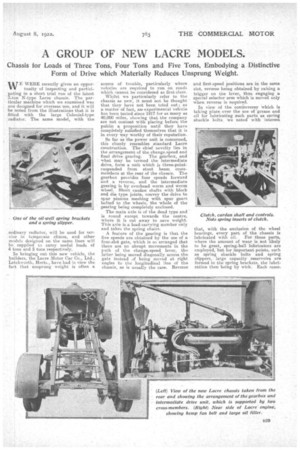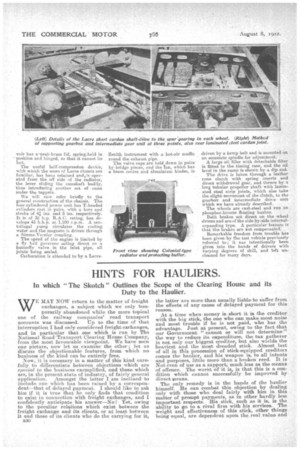A GROUP OF NEW LACRE MODELS.
Page 13

Page 14

If you've noticed an error in this article please click here to report it so we can fix it.
Chassis for Loads of Three Tons, Four Tons and Five Tons, Embodying a Distinctive Form of Drive which Materially Reduces Unsprung Weight.
WE WERE recently given an opportunity of inspecting and participating in a short trial run of the lateSt 3-ton N-type Lacre chassis. The particular machine which we examined was one designed for overseas use, audit will be noted from the illustrations that it is fitted with the large Colonial-type radiator. The same model, with the
Ordinary radiator, will be used for service in temperate climes, and other models designed on the same lines will ha supplied to carry useful loads of 4 tons and 5 tons respectively.
In bringing out this new vehicle, the builders, the Lacre Motor Car Co., Ltd-, Letchworth, Herts., have had in view the fact that unsprung weight is often a source of trouble, particularly where vehicles are required to run an roads which cannot be considered as first-class.
Whilst we particularly refer to the chassis as new, it must not be thought that they have not been tried out; as a matter of fact, an-experimental vehicle has been tested since 1917 for as many as 40,000 miles, showing that the company are not content with placing before the public a proposition until they have completely satisfied themselves that it is in every way worthy of their reputation:So far as the power unit is concerned; this closely resembles standard Leese construction. The chief novelty lies in the arrangement of the change-speed and
final drive gearing. The gearbox, and what may be termed the intermediate drive, form a unit which is three-pointsuspended from stout beam crossmembers at the rear of the chassis. The gearbox provides four speeds forward and a reverse, and the intermediate gearing is by overhead worm and worm Wheel. Short cardan shafts with block and die type joints, convey the drive to spur pinions meshing with spur gears bolted to thewheels, the whole of the gearing being completely enclosed.
The main axle is of the dead typo and is round except towards the centre, where it is cut away to save weights This axle is a load-Carrying member only and takes the spring chairs.
A feature of the gearing is that the five speeds are obtained by the use of a four-slot gate, which is so arranged that there are no abrupt movements in the path of the change-speed lever, the latter being moved diagonally across the gate instead of being moved at right angles to the longitudinal line of the chassis, as is usually the case. Reverse and first-speed positions are in the same slot, reverse being obtained by raising a trigger on the lever, thus engaging a special selectorarm which is moved only when reverse is required.
In view of the controversy which is taking place over the use of grease and oil for lubricating such parts as spring shackle bolts, we noted with interest that, with the exclusion of the wheel bearings, every part of the chassis is lubricated with oil. Fot those parts, where the amount of wear is not likely to be great, spring-hall lubricators are employed, but for important points, such as spring shackle bolts and spring slippers, large caPacity reservoirs are formed in the spring brackets, the lubrication then being by wickEach' reser
voir has ryneat-brass Id, spring-held in -position and hinged, so that it cannot be lost.
The useful half:compression device, with which the users of Lacre chassis are familial., has been retained and, is operated from the off side of the radiator, the lever sliding the camshaft bodily, thus introducing another set of cams under the tappets.
We will now refer briefly to the general construction of the chaisis. The four-cylindered power unit has T-headed cylinders cast in pairs. with a bore and stroke of 47, ins. and 5 ins. respectively. It is of 38 h.p. R.A.C. rating, but deselops 45 b.h.p. at 1,100 r.p.m. A centrifugal pump circulates the cooling water and the magneto is driven through a S'imres-Vernier coupling.
The speed of the engine is limited by a fly hall governor acting direct on a butterfly valve in the inlet pipe, all joints •being sealed. Carburation is attended to by a Lacre. Zenith instrument with a hot-air muffle round the exhaust pipe. The valve. caps are held down in pairs by bridge pieces, and the Tan, which has a brass centre and aluminium blades, is driven by a hemp belt and is mounted on an eccentric spindle for adjustment. A large oil filler with detachable filter is fitted to the timing case, and the oil level in the sump is shown by a dip rod. The drive is taken through a leather cone clutch with spring inserts and direct withdrawal gear, and thence by a . long tubular propeller shaft with laminated steel strip joints, which also tale the slight movement of the clutch, to the gearbox and intermediate drive unit which we have already described. The wheels are cast-steel and run on phosphor-bronze floating bashes,. Both brakes act direct on the wheel drums and are of the side-by-side internalexpanding type. A particular feature is that the brakes are Rot compensated: Remarkable freedom from trouble has been given by the test vehicle previously referred to ; it nas intentionally been ' given into the hands of drivers with varying degrees of skill, and left uncleaned for many days.
































